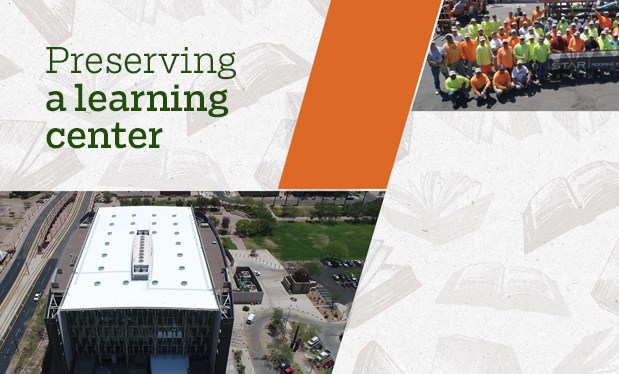Editor's note: The opinions in this article are those of the author and not NRCA.
As land continues to be lost to construction and new structures are built to accommodate population and urbanization growth, it is critical to create new "green" spaces for the quality of the environment. One method you can recommend to your customers is to replace their traditional roof systems with vegetative roof systems.
A vegetative roof system, also known as a garden roof or green roof, is a layered roof system that grows practically maintenance-free plants on a flat or slightly sloped waterproofed substructure. These roof systems provide environmental, construction, corporate and social benefits while improving your bottom line.
Benefits
Vegetative roof systems provide numerous environmental benefits, such as reducing the effects of urban heat islands, decreasing waste and providing urban ecosystems, according to greenroofs.org.
Vegetative roof systems greatly reduce rooftop air temperature when compared with traditional roof systems as a result of differences in color. Traditional roof systems tend to be composed of darker-colored materials than eco-friendly roof systems and absorb more energy than lighter-colored materials.
Lowering the urban heat island effect can reduce the workload of a building's HVAC system, resulting in energy savings. The service lives of ventilation and HVAC systems also can be elongated because of decreased usage from reduced urban heat island effects, saving money and reducing materials needed for repairs or replacement.
In addition, a vegetative roof system can decrease waste from building maintenance and provide natural wildlife habitats, where produce can grow, and various birds and insects can be housed. Even a small rooftop garden is beneficial to the ecosystem in an urban area where most structures are made from concrete or metal.
In addition to these environmental benefits, vegetative roof systems also can retain excess stormwater. Vegetative roof systems manage rainwater with moisture-retention mats, and the growth media (soil) acts as a sponge to buffer drainage. This allows water to be released over time, through evaporation, stabilizing groundwater levels and reducing peak water loads on sewage systems. When drainage is decelerated, the risk of water damage to a structure is reduced. Vegetative roof systems are particularly useful in urban areas where stormwater management options are limited.
More jobs
Growth in the eco-friendly roofing market creates job opportunities in the manufacturing, plant growth, design, installation and maintenance fields. As a result of the increased popularity of vegetative roof systems, there is substantial potential for more growth in these job areas, especially in urban areas where vegetative roof systems previously were believed to be unusable.
Selling points
When presenting vegetative roof system options to potential customers, the following top benefits should be at the forefront of your roofing proposal.
Noise attenuation
A properly maintained roof system not only protects a building, but it also offers a comfortable living environment for those inside. Vegetative roof systems provide excellent noise attenuation, especially for low-frequency sounds. The media, plants and drainage layers act as a noise insulation barrier by absorbing sound vibrations to create a quieter space for building occupants. This leads to a more comfortable environment, which also can increase a property's value.
Improved air quality
Along with silencing noise, vegetative roof systems improve air quality. A vegetative roof system's foliage filters the air from noxious gases and captures airborne pollutants and atmospheric deposition. In addition to air filtration, plants absorb carbon dioxide and release oxygen. This potentially decreases the amount of carbon dioxide and other pollutants being released into the air.
Visually appealing space
A majority of vegetative roof system designs feature a garden, which creates a visually appealing space in an otherwise unused and often overlooked area. A screen wall can be added to the landscape, as well, providing a visual break from the area surrounding the roof. This can contribute to a positive work or living environment, which, in turn, creates more valuable space for building owners and potential residents.
Things to consider
Before you move forward with installing a vegetative roof system, there are several factors to explain to your customer, such as existing construction, cost, material selection, irrigation, water management and potential photovoltaic (PV) panel integration.
For example, one of my clients strongly wanted to install a garden roof on an office building during a scheduled renovation. After gathering information about the existing structure and construction, I discovered the building could not support the additional weight of a traditional intensive system. I explained this to the customer, who then decided to compromise for a tray system, which is much lighter than a deep, intensive vegetative system.
Of course, cost also must be discussed. The price for installing a vegetative roof system can be upwards of $45 per square foot for the garden materials alone. This is expensive, but in the long run, the energy savings can offset the initial installation cost.
Material selection
When choosing materials for a vegetative roof system, selecting native vegetation that naturally populates the local climate zone is best for easy upkeep and a greater plant survival rate. The roofing materials then are purposefully blended to meet a specific usage and weight specification to prevent arbitrary purchasing of top soil and flowers that could jeopardize the success of the vegetative roof system.
Engineered growth media used for a vegetative roof system is modified with the intended plants and garden depth. Material selection also varies greatly depending on the vegetative roof system's design—the only limit is the artistry and skill of those constructing the roof.
Irrigation
Irrigation choice is imperative depending on plant selection and intended foliage use. Greenery can be as simple as a patch of grass or as complex as a landscape with several different features. Depending on usage, vegetative roof systems can be classified as intensive, extensive or modular trays.
Intensive vegetative roof systems have a larger soil layer and most often an irrigation system that leads to more favorable conditions for deep-rooted plants, such as trees, shrubs and prairie grasses for a traditional garden design. Because of these requirements, intensive vegetative roof systems are more expensive than extensive vegetative roof systems and modular tray systems.
Extensive vegetative roof systems and modular tray systems typically do not include a garden, are low-maintenance and have little to no irrigation systems, so their landscapes are simple. Because of these conditions, there is a limited foliage type that can be grown, traditionally a sedum variety—a type of succulent. When comparing different vegetative roof system techniques, modular trays typically are the least expensive option with intensive vegetative roof systems being a premium choice.
Water management
Waterproofing material also is important to the success of a vegetative roof system project. It is critical the material is installed correctly with the proper root-control system, but this can be difficult to accomplish after all the garden materials are in place. Because of a challenging installation process, I strongly encourage testing the roof membrane before overburden placement.
Stormwater management can be affected by the type and depth of media used as well as the drainage of moisture from media based on intended use and plant selection. Vegetative roof systems have several components to mitigate stormwater.
First, rainwater is intercepted by plants before it reaches the growing medium. Most of the rain is absorbed and filtered through the growing medium and through the filter fabric sheet to the drainage layer. Then, it flows from the drainage layer to the root barrier, which protects the roof system from the plants' root infrastructures. Together, these layers create a complex and effective method to collect and filtrate rainwater. This makes it crucial to use correct, compatible materials for the best overall coverage of a roof.
PV panels
With the growth of solar, many building owners are looking to combine vegetative roof systems with PV panels. For the overall efficiency of a vegetative roof system, PV panel additions should be designed to limit vegetation obstruction. Designed as on-grid systems, PV panels require certified installers to ensure worker safety.
PV panels can create a challenge with roof flashing and some commercially available panel rack assemblies that require appropriate due diligence by all roofing, electrical and vegetative contractors.
For example, I have been involved in several repair projects where the panel racks were installed through the existing roof membrane and not flashed properly, resulting in leaks. Another repair project involved panels that were not secured properly to the racks, and they blew off in a strong storm and punctured the roof membrane in several areas. We were able to fix these problems by repairing the loose connections and securing the loose panels.
Maintenance
With a vegetative roof system, maintenance typically is performed monthly through the first growing season and then quarterly after the vegetation is established. Vegetative roof systems also will need to be checked after significant weather events to ensure everything is functioning properly.
Items to be addressed during upkeep include visual inspection of the roof and garden areas, hand-weeding, removal of debris, verification of appropriate soil moisture and irrigating as required.
Sustainable assurance
Facility managers and building owners can ensure a building's vegetative roof system will be efficiently sustainable by beginning the building process with attainable expectations. These expectations also must match the construction budget and structural limitations. Material compatibility between the climate, waterproofing materials and foliage is important, as well.
Without careful planning and cohesion between the materials, the roof system will not reach its highest efficiency potential. It is important to coordinate waterproofing, irrigation, stormwater management, media selection, load requirements, plant selection and more. When properly installed, vegetative roof systems provide a multitude of benefits for the environment, our communities, your new customers and your bottom line.
Bill Klein is estimator and project manager for RSS Roofing Services & Solutions, St. Louis.
Did you Know?
The NRCA Vegetative Roof Systems Manual, Third Edition, provides technical information for the design and installation of quality vegetative roof systems. For more information, go to shop.nrca.net.



